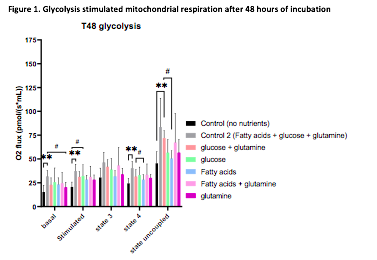The effect of different nutrients on mitochondrial function during long term incubation of precision-cut kidney slices
L. Annick van Furth1, Dafni Efraimoglou1, Leonie H Venema1, Peter Olinga2, Albert Gerding3, Barbara M Bakker3, Ron W F de Bruin4, Henri G D Leuvenink1.
1Surgery, organ donation and transplantation, University Medical Centre, Groningen, Netherlands; 2Farmaceutical technology and biopharmacy, University of Groningen, Groningen, Netherlands; 3Pediatrics, University Medical Centre, Groningen, Netherlands; 4Experimental surgery, Erasmus Medical Centre, Rotterdam, Netherlands
Introduction: Marginal donor kidneys are more susceptible to ischemia-reperfusion injury (IRI). IRI causes the mitochondria to produce reactive oxygen species (ROS) after reintroduction of oxygen. To diminish production and deleterious effects of ROS, mitochondria should be preserved optimally between donation and transplantation. Normothermic machine perfusion (NMP) is increasingly explored to improve quality during preservation. One important question is how to provide metabolic support to kidneys during NMP and which nutrients are best to support mitochondrial energy production. To resemble NMP circumstances, we developed a precision-cut kidney slices model that can study the kidney on a cellular level. The aim of this study is to investigate the effect of different nutrients on mitochondrial function during incubation of precision-cut kidney slices.
Methods: Pig kidneys were procured at a local slaughterhouse. After 30 minutes of warm ischemia kidneys were perfused with oxygenated hypothermic machine perfusion for 3 hours. For the human kidney, a cortical peace was cut off and put on cold storage until arrival at the lab. Thereafter, precision-cut kidney slices (PCKS) were made and incubated for 24 or 48 hours in different incubation media. The basic incubation medium was Dulbecco's Modified Eagle Medium (DMEM) without glucose and pyruvate supplemented with ciprofloxacine (10 µg/mL) and fungizone (0,25 µg/mL). To the groups either glucose, glutamine and/or fatty acids were added (table 1). At zero, 24 and 48 hours, mitochondrial respiration, using the Oxygraph-2k, was assessed, in which the glycolysis (pyruvate and glutamate) and the beta-oxidation of fatty acids (C16-carnitine) were stimulated. Furthermore, mitochondrial energy status and injury markers in the incubation medium were analyzed.

Results: Mitochondrial respiration, in terms of the respiratory control ratio (RCR), after HMP is best when only glutamate is used to stimulate. Furthermore, mitochondria were better preserved after 48 hours with the addition of glucose, glutamine and fatty acids compared to no nutrients. No differences were seen between glycolysis or fatty acid stimulation.
Conclusion: Nutrient composition impacts mitochondrial function of precision cut kidney slices. These data pave the way to optimize the perfusion solution for NMP of marginal donors.

right-click to download
